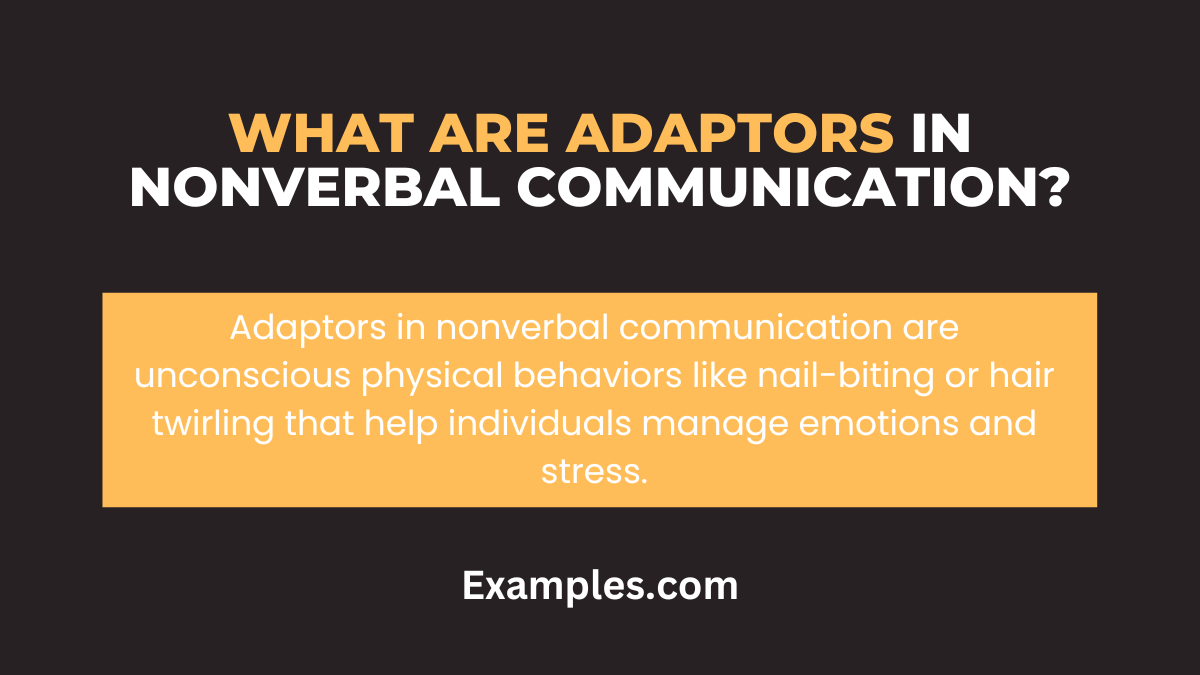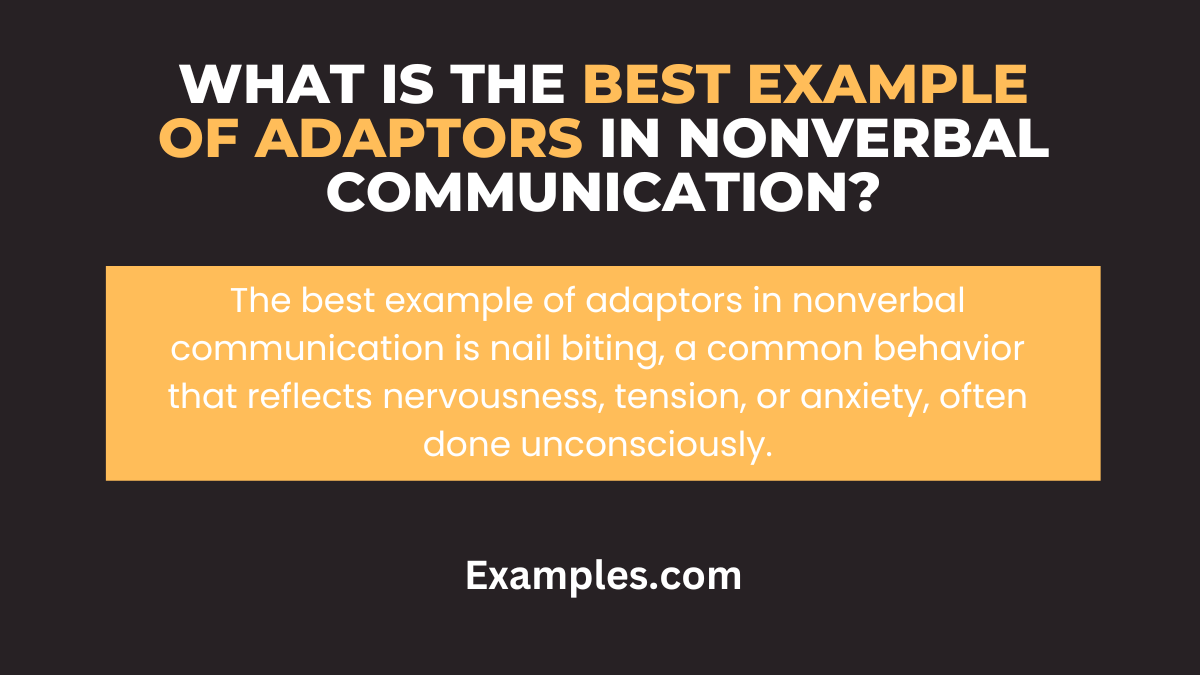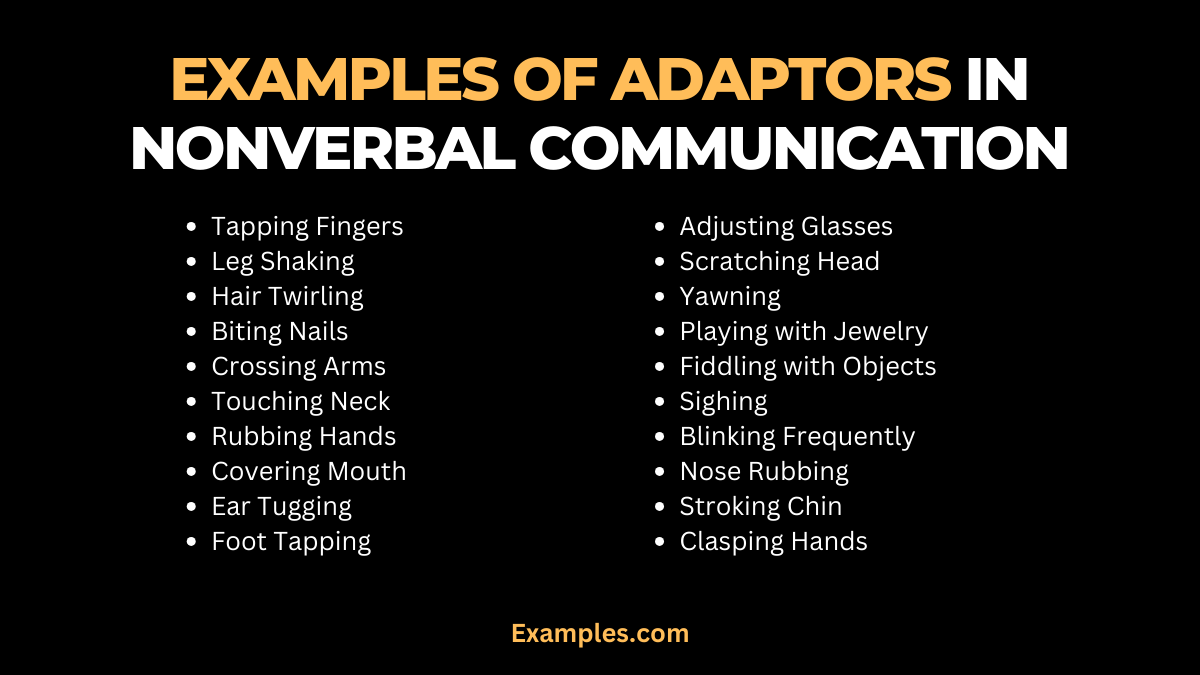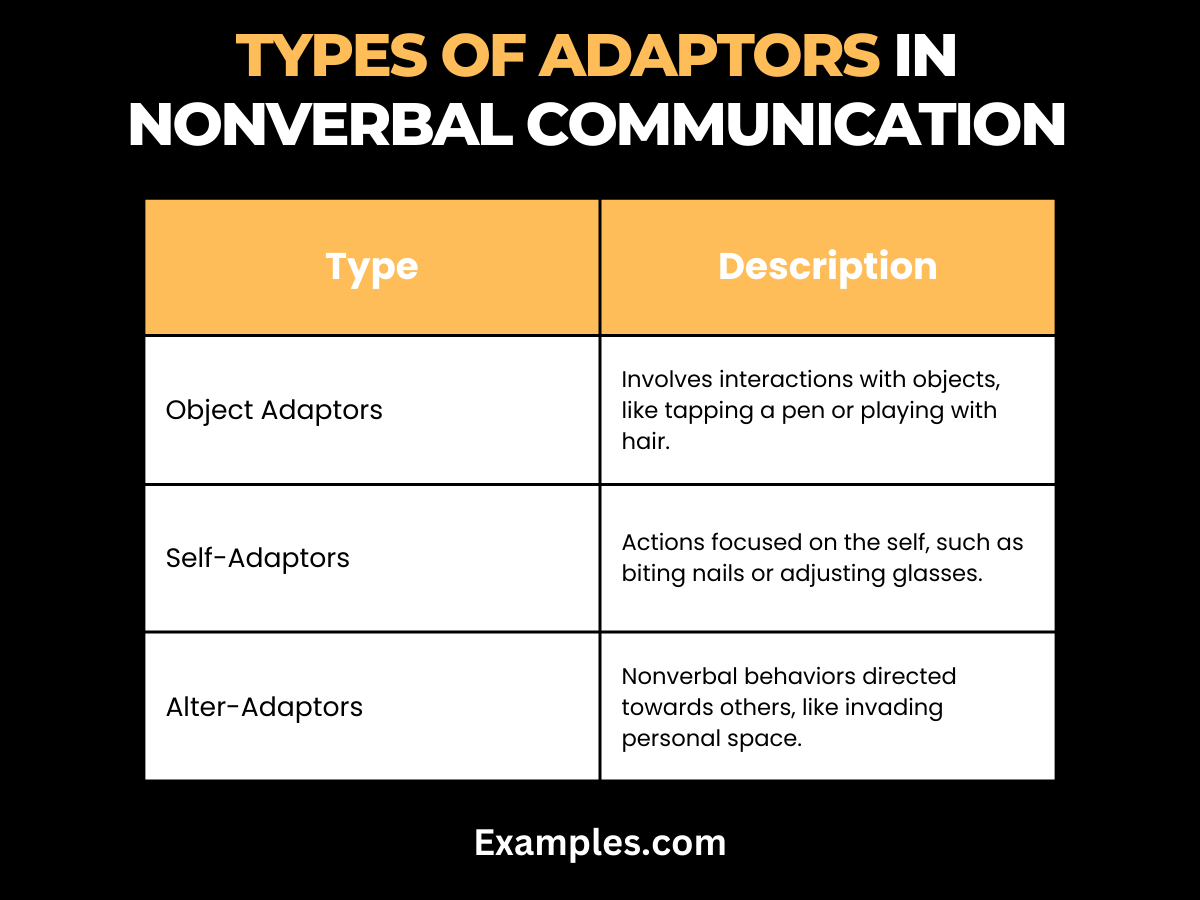19+ Adaptors in Nonverbal Communication Examples
Delve into the fascinating world of adaptors in nonverbal communication. This guide offers a thorough exploration of how subtle yet impactful adaptors can be in conveying messages and emotions without words. From the twitch of an eyebrow to the tapping of a foot, understand the intricate ways our body language complements and sometimes contradicts our spoken words. Ideal for anyone keen to enhance their communication skills, this guide is packed with examples and practical tips, providing a clear understanding of this vital aspect of human interaction.
What are Adaptors in Nonverbal Communication?

Adaptors are subconscious behaviors that often reveal our true feelings and thoughts. They are a key component of nonverbal communication, encompassing various physical movements or gestures that we make, sometimes unconsciously, in response to our environment or internal emotions. These can range from fidgeting when nervous to nodding during a conversation, offering a window into our unspoken emotions and reactions.
What is the Best Example of Adaptors in Nonverbal Communication?

A classic example of an adaptor in nonverbal communication is fidgeting, such as tapping a foot or twirling hair, especially when one is anxious or bored. Another significant example is the use of personal space; how close or far we stand from someone can communicate comfort or discomfort. These adaptors, often overlooked, play a crucial role in how we express and perceive emotions, making them an essential aspect of effective interpersonal communication.
20 Examples of Adaptors in Nonverbal Communication

Adaptors are subtle yet powerful components in nonverbal communication. They often reveal underlying emotions or reactions and can significantly influence interactions. This list explores 20 unique adaptors, each with a brief explanation and example sentences, to illustrate their role in body language and interpersonal dynamics.
- Tapping Fingers: Tapping fingers is a common non-verbal behavior that indicates impatience or anxiety. It often manifests as rapid, rhythmic movements of one’s fingers against a surface, such as a table or desk. This action signifies a restless and anxious state of mind, where a person may be awaiting a response or facing a situation that makes them uneasy.
Example: While waiting for a response, John tapped his fingers rapidly on the table. - Leg Shaking: Leg shaking is a physical expression of nervousness or restlessness. It typically involves the repetitive movement of one’s leg, either subtly or vigorously, while seated or standing. This behavior can be a clear sign of inner tension, discomfort, or anticipation, especially in situations like interviews or important meetings.
Example: During the interview, her leg shook subtly under the table. - Hair Twirling: Hair twirling is a non-verbal cue that often indicates deep thinking or boredom. Individuals engaged in this action absentmindedly twist or twirl strands of their hair around their fingers. It can be a way to channel one’s thoughts during moments of contemplation or a sign of disinterest or restlessness when facing dull or unengaging situations.
Example: Lost in thought, she absentmindedly twirled her hair. - Biting Nails: Biting nails reflects stress or insecurity. When confronted with challenging or stressful situations, some people resort to biting their nails as a coping mechanism. This behavior can be a subconscious way to deal with anxiety or nervousness, and it may indicate a lack of confidence or self-assurance.
Example: Faced with a difficult question, he began to bite his nails. - Crossing Arms: Crossing arms is a common body language gesture that can suggest defensiveness or self-protection. It involves folding one’s arms across the chest, creating a physical barrier. People often adopt this posture when they feel the need to guard themselves emotionally or when they disagree with something being discussed, signaling a defensive stance.
Example: As the debate heated up, she crossed her arms tightly. - Touching Neck: Touching the neck is a non-verbal signal that indicates discomfort or uncertainty. When individuals gently touch or rub their necks, it can signify that they are feeling uneasy, anxious, or hesitant. This gesture often accompanies moments of self-doubt or when responding to questions that make them feel vulnerable.
Example: He touched his neck gently when asked about his decision. - Rubbing Hands: Rubbing hands together shows anticipation or anxiety. It involves the repetitive action of rubbing one’s palms against each other. This behavior is typically associated with excitement or nervousness about something upcoming, such as an announcement or an event. It can convey a mix of emotions, including anticipation and anxiety.
Example: Rubbing her hands together, she awaited the announcement. - Covering Mouth: Covering the mouth suggests withholding information or surprise. When someone covers their mouth, it can be a subconscious attempt to conceal their immediate reaction, which could be shock, surprise, or the desire to hold back words. This gesture is often seen when individuals want to keep their thoughts or emotions hidden.
Example: She covered her mouth in shock at the news. - Ear Tugging: Ear tugging reflects indecision or self-soothing. People may tug or touch their earlobes when they are uncertain or when they seek comfort during moments of stress or discomfort. It can be a sign of inner turmoil or a way to self-soothe in challenging situations.
Example: Unsure of his answer, he tugged at his earlobe. - Foot Tapping: Foot tapping signals impatience or eagerness. It involves the rhythmic movement of one’s foot, often accompanied by a tapping motion. This behavior expresses a strong desire for something to happen or an eagerness to move forward. It can be a clear indicator of impatience, particularly in situations involving waiting or anticipation.
Example: He tapped his foot rapidly during the long wait. - Adjusting Glasses: When someone adjusts their glasses, it often signifies thoughtfulness or disagreement. This action can be seen when an individual is contemplating a matter or expressing their disagreement with a statement, as they subconsciously adjust their eyewear.
Example: Adjusting his glasses, he pondered the question. - Scratching Head: Scratching one’s head implies confusion or forgetfulness. This gesture is a non-verbal sign that someone is trying to recall information or is puzzled by a situation, often accompanied by a puzzled expression.
Example: Scratching his head, he tried to remember the details. - Yawning: Yawning is commonly associated with boredom or tiredness. When someone yawns, it can suggest that they are disinterested or fatigued, although they may try to conceal it to appear engaged.
Example: She yawned subtly, trying not to appear disinterested. - Playing with Jewelry: Playing with jewelry, such as bracelets or rings, indicates nervousness or distraction. This behavior is observed when individuals fidget with their adornments as a way to cope with anxiety or when they are not fully engaged in the present moment.
Example: Playing with her bracelet, she listened to the lecture. - Fiddling with Objects: Fiddling with objects is a sign of restlessness or anxiety. People tend to fidget with items like pens, coins, or other small objects when they are feeling anxious, impatient, or uneasy.
Example: Fiddling with a pen, he awaited his turn to speak. - Sighing: Sighing expresses exhaustion or relief. A heavy sigh can indicate that someone has just completed a challenging task and is relieved, or it may signal that they are mentally or physically tired.
Example: After completing the task, she sighed heavily. - Blinking Frequently: Frequent blinking can suggest disbelief or stress. When someone blinks rapidly, it may indicate that they are trying to process unexpected or stressful information.
Example: He blinked rapidly, processing the unexpected news. - Nose Rubbing: Nose rubbing implies doubt or rejection. This action is often seen when someone is skeptical about a proposal or decision and may be subtly expressing their disbelief or hesitation.
Example: Rubbing his nose, he contemplated the offer. - Stroking Chin: Stroking one’s chin reflects deep thinking or judgment. When individuals ponder a matter or weigh pros and cons, they often stroke their chin as they engage in thoughtful contemplation.
Example: Stroking his chin, he weighed the pros and cons. - Clasping Hands: Clasping hands shows confidence or control. This gesture conveys a sense of self-assuredness and can be observed when individuals want to appear composed and in charge during various situations, such as delivering a speech or making a decision.
Example: With hands clasped, she delivered her speech confidently.
Types of Adaptors in Nonverbal Communication

| Type | Description |
|---|---|
| Object Adaptors | Involves interactions with objects, like tapping a pen or playing with hair. |
| Self-Adaptors | Actions focused on the self, such as biting nails or adjusting glasses. |
| Alter-Adaptors | Nonverbal behaviors directed towards others, like invading personal space. |
Role of Adaptors in Nonverbal Communication
Adaptors play a pivotal role in Nonverbal Communication. These seemingly minor actions can convey significant insights into a person’s emotional state, stress levels, and intentions. Understanding adaptors enhances one’s ability to interpret the subtleties of Nonverbal Communication, crucial in contexts like workplace interactions or cross-cultural communication.
Understanding Emotional States
Adaptors can reveal emotions that might not be verbally expressed. For instance, someone repeatedly touching their face or neck might indicate nervousness or discomfort.
Indicating Stress Levels
Self-adaptors, in particular, often manifest under stress. Recognizing these signs can help in adjusting communication strategies to ease the situation.
Enhancing Cross-Cultural Communication
Different cultures may interpret adaptors differently. Awareness of these nuances is vital in international contexts to avoid misunderstandings.
Facilitating Better Workplace Interactions
In a professional setting, being mindful of adaptors can improve communication and collaboration. It helps in understanding non-verbal cues of colleagues, leading to a more empathetic and efficient work environment.
In conclusion, adaptors in nonverbal communication offer a nuanced lens through which we can better understand and interact with the world around us. These subtle physical movements and gestures, often performed unconsciously, provide insights into a person’s emotional state and intentions, enhancing our ability to communicate effectively in various social and professional settings.



